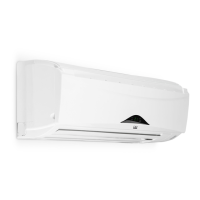"NETWORK" key
The "NETWORK" key enables the settings on the
master unit (leading unit) to be transferred to all
slave units (following units) on the network. All
units confirm that they have received the settings
correctly by beeping. The infrared remote controls
do not copy the changed settings. Press and hold
the key for 3 seconds to transfer
. However, each
individual unit can still be operated individually.
Fig. 25: "NETWORK" key
A: Transfer to all units. Confirmation by means of
a signal tone
Master/slave behaviour
If multiple units are installed, for example within a
room, a higher-level unit (leading unit = master)
can transfer the remote control's settings to all
lower-level units (following unit = slave). T
o transfer
the data, the leading unit (master) is connected to
the following units (slave). The master unit can be
operated via a standard infrared remote control or
via a fixed cabled remote control (accessory). The
data that is sent is then transferred to all other
slave units via the internal bus line. The number of
slave units is limited to 31.
Fig. 26: "NETWORK" key - Master/slave behaviour
Two different network variants are available:
1. Operating a group:
Leading unit (master) function:
Standard IR or alternative cabled remote control of
the
master unit can address the master and all
slave units .
Subsequent unit (slave) function:
Standard IR or alternative cabled remote control of
the slave unit can operate the addressed slave unit
only .
Operating a group or specific units within a
group:
Leading unit (master) function:
Cabled remote control available as an accessory
for the master unit can address the master unit, all
slave units as a group or individual slave units sep-
arately . Subsequent unit (slave) function:
Cabled remote control available as an accessory
for the slave unit can operate the connected slave
unit only.
29

